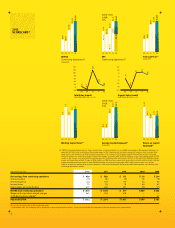Black & Decker 2012 Annual Report Download - page 20
Download and view the complete annual report
Please find page 20 of the 2012 Black & Decker annual report below. You can navigate through the pages in the report by either clicking on the pages listed below, or by using the keyword search tool below to find specific information within the annual report.
6
Patents and Trademarks
No business segment is dependent, to any significant degree, on patents, licenses, franchises or concessions, and the loss of
these patents, licenses, franchises or concessions would not have a material adverse effect on any of the business segments. The
Company owns numerous patents, none of which individually is material to the Company's operations as a whole. These
patents expire at various times over the next 20 years. The Company holds licenses, franchises and concessions, none of which
individually or in the aggregate are material to the Company's operations as a whole. These licenses, franchises and
concessions vary in duration, but generally run from one to 40 years.
The Company has numerous trademarks that are used in its businesses worldwide. In the CDIY segment, the STANLEY®,
FatMax®, D
E
WALT®, Black & Decker®, Bostitch®, Bailey®, Powerlock®, Tape Rule Case Design®, DustBuster®, Porter-
Cable®, and Workmate® of trademarks are material. The STANLEY®, BEST®, Blick™, HSM®, Sargent & Greenleaf®,
S&G® Sonitrol®, Niscayah®, and Xmark® trademarks are material to the Security segment. The D
E
WALT®, CRC®,
LaBounty®, MAC®, Mac Tools®, Proto®, Vidmar®, Facom®, and Emhart Teknologies™ trademarks are material to the
Industrial segment. The terms of these trademarks typically vary from 10 to 20 years, with most trademarks being renewable
indefinitely for like terms.
Environmental Regulations
The Company is subject to various environmental laws and regulations in the U.S. and foreign countries where it has
operations. Future laws and regulations are expected to be increasingly stringent and will likely increase the Company’s
expenditures related to environmental matters.
In the normal course of business, the Company is involved in various lawsuits and claims. In addition, the Company is a party
to a number of proceedings before federal and state regulatory agencies relating to environmental remediation. The Company’s
policy is to accrue environmental investigatory and remediation costs for identified sites when it is probable that a liability has
been incurred and the amount of loss can be reasonably estimated. In the event that no amount in the range of probable loss is
considered most likely, the minimum loss in the range is accrued. The amount of liability recorded is based on an evaluation of
currently available facts with respect to each individual site and includes such factors as existing technology, presently enacted
laws and regulations, and prior experience in remediation of contaminated sites. The liabilities recorded do not take into
account any claims for recoveries from insurance or third parties. As assessments and remediation progress at individual sites,
the amounts recorded are reviewed periodically and adjusted to reflect additional technical and legal information that becomes
available. As of December 29, 2012 and December 31, 2011, the Company had reserves of $188.0 million and $164.8 million,
respectively, for remediation activities associated with Company-owned properties, as well as for Superfund sites, for losses
that are probable and estimable. Of the 2012 amount, $6.0 million is classified as current and $182.0 million as long-term,
which is expected to be paid over the estimated remediation period. As of December 29, 2012, the Company has recorded an
asset of $24.3 million related to funding by EPA and placed in trust in accordance with the Consent Decree associated with the
West Coast Loading Corporation ("WCLC") proceedings, as further discussed in Note S, Contingencies, of the Notes to
Consolidated Financial Statements in Item 8. Accordingly, the cash obligation as of December 29, 2012 of the Company
associated with the aforementioned remediation activities is $163.7 million. The range of environmental remediation costs that
is reasonably possible is $141 million to $283 million, which is subject to change in the near term. The Company may be liable
for environmental remediation of sites it no longer owns. Liabilities have been recorded on those sites in accordance with
policy.
The amount recorded for identified contingent liabilities is based on estimates. Amounts recorded are reviewed periodically and
adjusted to reflect additional technical and legal information that becomes available. Actual costs to be incurred in future
periods may vary from the estimates, given the inherent uncertainties in evaluating certain exposures. Subject to the
imprecision in estimating future contingent liability costs, the Company does not expect that any sum it may have to pay in
connection with these matters in excess of the amounts recorded will have a materially adverse effect on its financial position,
results of operations or liquidity. Additional information regarding environmental matters is available in Note S, Contingencies,
of the Notes to Consolidated Financial Statements in Item 8.
Employees
At December 29, 2012, the Company had 45,327 employees, 12,500 of whom are employed in the U.S. Approximately 800
U.S. employees are covered by collective bargaining agreements negotiated with 21 different local labor unions who are, in
turn, affiliated with approximately 6 different international labor unions. The majority of the Company’s hourly-paid and
weekly-paid employees outside the U.S. are not covered by collective bargaining agreements. The Company’s labor
agreements in the U.S. expire in 2013 and 2014. There have been no significant interruptions of the Company’s operations in
recent years due to labor disputes. The Company believes that its relationship with its employees is good.
























